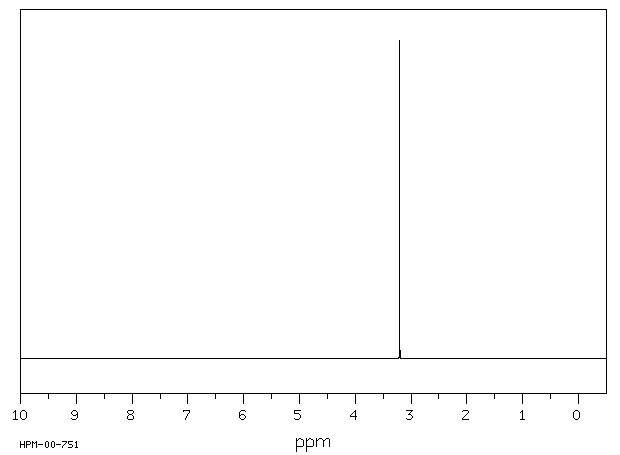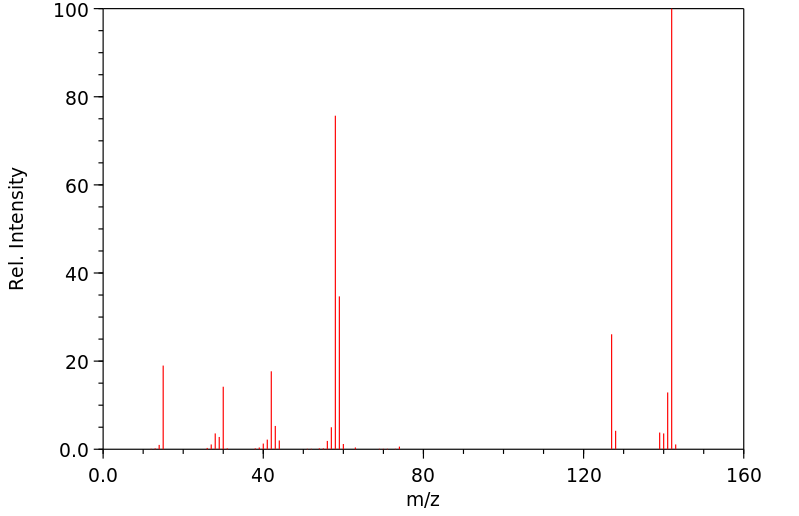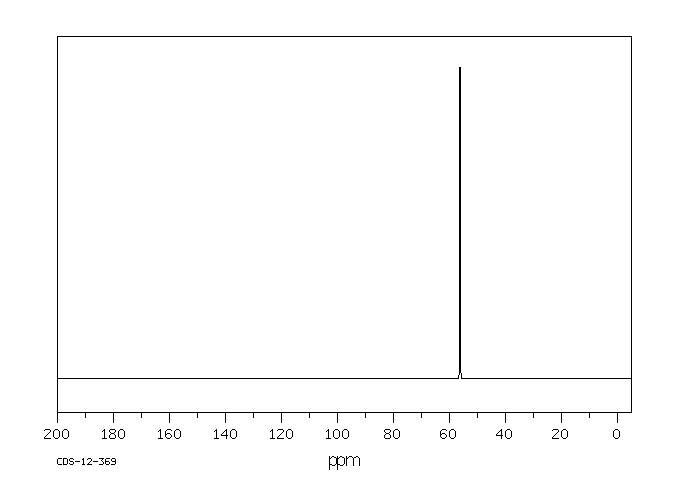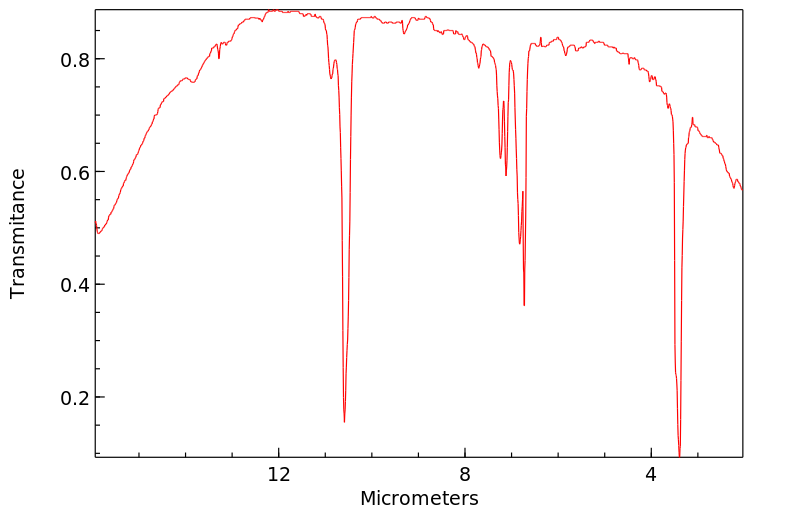四甲基碘化铵 | 75-58-1
中文名称
四甲基碘化铵
中文别名
碘化四甲碘;N,N,N-三甲基-1-甲铵碘化物;碘化四甲基铵;碘化四甲胺;碘化四甲铵
英文名称
tertamethylammonium iodide
英文别名
tetramethyl-ammonium iodide;TMAI;Tetramethylazanium;iodide
CAS
75-58-1
化学式
C4H12N*I
mdl
——
分子量
201.05
InChiKey
RXMRGBVLCSYIBO-UHFFFAOYSA-M
BEILSTEIN
——
EINECS
——
-
物化性质
-
计算性质
-
ADMET
-
安全信息
-
SDS
-
制备方法与用途
-
上下游信息
-
文献信息
-
表征谱图
-
同类化合物
-
相关功能分类
-
相关结构分类
物化性质
-
熔点:>300 °C (lit.)
-
密度:1.84 g/cm3
-
暴露限值:ACGIH: TWA 0.01 ppm
-
稳定性/保质期:
稳定但对光敏感且易吸湿。应存放在干燥暗处的容器中。
计算性质
-
辛醇/水分配系数(LogP):-2.67
-
重原子数:6
-
可旋转键数:0
-
环数:0.0
-
sp3杂化的碳原子比例:1.0
-
拓扑面积:0
-
氢给体数:0
-
氢受体数:1
安全信息
-
TSCA:Yes
-
危险等级:6.1
-
危险品标志:Xi
-
安全说明:S24/25,S26,S36
-
危险类别码:R36/37/38
-
WGK Germany:3
-
海关编码:29239000
-
RTECS号:PA1050000
-
危险性防范说明:P261,P301+P312,P302+P352,P304+P340,P305+P351+P338
-
危险性描述:H302,H315,H319,H335
-
储存条件:本品应密封存放在阴凉干燥处,并避免光照。
SDS
1.1 产品标识符
: Tetramethylammonium iodide
化学品俗名或商品名
1.2 鉴别的其他方法
无数据资料
1.3 有关的确定了的物质或混合物的用途和建议不适合的用途
仅供科研用途,不作为药物、家庭备用药或其它用途。
模块 2. 危险性概述
2.1 GHS分类
皮肤刺激 (类别2)
眼刺激 (类别2A)
特异性靶器官系统毒性(一次接触) (类别3)
2.2 GHS 标记要素,包括预防性的陈述
危害类型象形图
信号词 警告
危险申明
H315 造成皮肤刺激。
H319 造成严重眼刺激。
H335 可能引起呼吸道刺激。
警告申明
预防
P261 避免吸入粉尘/ 烟/ 气体/ 烟雾/ 蒸汽/ 喷雾。
P264 操作后彻底清洁皮肤。
P271 只能在室外或通风良好之处使用。
P280 穿戴防护手套/ 眼保护罩/ 面部保护罩。
措施
P302 + P352 如果在皮肤上: 用大量肥皂和水淋洗。
P304 + P340 如果吸入: 将患者移到新鲜空气处休息,并保持呼吸舒畅的姿势。
P305 + P351 + P338 如进入眼睛:用水小心清洗几分钟。如戴隐形眼镜并可方便地取出,取出
隐形眼镜。继续冲洗。
P312 如感觉不适,呼救解毒中心或医生。
P321 具体治疗(见本标签上提供的急救指导)。
P332 + P313 如发生皮肤刺激:求医/ 就诊。
P337 + P313 如仍觉眼睛刺激:求医/ 就诊。
P362 脱掉沾染的衣服,清洗后方可重新使用。
储存
P403 + P233 存放于通风良的地方。 保持容器密闭。
P405 存放处须加锁。
处理
P501 将内容物/ 容器处理到得到批准的废物处理厂。
2.3 其它危害物 - 无
模块 3. 成分/组成信息
3.1 物 质
: C4H12IN
分子式
: 201.05 g/mol
分子量
成分 浓度
Tetramethylammonium iodide
-
化学文摘编号(CAS No.) 75-58-1
EC-编号 200-881-3
模块 4. 急救措施
4.1 必要的急救措施描述
一般的建议
请教医生。 出示此安全技术说明书给到现场的医生看。
如果吸入
如果吸入,请将患者移到新鲜空气处。 如果停止了呼吸,给于人工呼吸。 请教医生。
在皮肤接触的情况下
用肥皂和大量的水冲洗。 请教医生。
在眼睛接触的情况下
用大量水彻底冲洗至少15分钟并请教医生。
如果误服
切勿给失去知觉者从嘴里喂食任何东西。 用水漱口。 请教医生。
4.2 最重要的症状和影响,急性的和滞后的
据我们所知,此化学,物理和毒性性质尚未经完整的研究。
4.3 及时的医疗处理和所需的特殊处理的说明和指示
无数据资料
模块 5. 消防措施
5.1 灭火介质
灭火方法及灭火剂
用水雾,耐醇泡沫,干粉或二氧化碳灭火。
5.2 源于此物质或混合物的特别的危害
碳氧化物, 氮氧化物, 碘化氢
5.3 救火人员的预防
如必要的话,戴自给式呼吸器去救火。
5.4 进一步的信息
无数据资料
模块 6. 泄露应急处理
6.1 人员的预防,防护设备和紧急处理程序
使用个人防护设备。 防止粉尘的生成。 防止吸入蒸汽、气雾或气体。 保证充分的通风。
将人员撤离到安全区域。 避免吸入粉尘。
6.2 环境预防措施
不要让产物进入下水道。
6.3 抑制和清除溢出物的方法和材料
收集、处理泄漏物,不要产生灰尘。 扫掉和铲掉。 存放在合适的封闭的处理容器内。
6.4 参考其他部分
丢弃处理请参阅第13节。
模块 7. 操作处置与储存
7.1 安全操作的注意事项
避免接触皮肤和眼睛。 防止粉尘和气溶胶生成。
在有粉尘生成的地方,提供合适的排风设备。
7.2 安全储存的条件,包括任何不兼容性
贮存在阴凉处。 容器保持紧闭,储存在干燥通风处。
对光线敏感 吸湿的.
7.3 特定用途
无数据资料
模块 8. 接触控制/个体防护
8.1 控制参数
最高容许浓度
没有已知的国家规定的暴露极限。
8.2 暴露控制
适当的技术控制
根据工业卫生和安全使用规则来操作。 休息以前和工作结束时洗手。
人身保护设备
眼/面保护
带有防护边罩的安全眼镜符合 EN166要求请使用经官方标准如NIOSH (美国) 或 EN 166(欧盟)
检测与批准的设备防护眼部。
皮肤保护
戴手套取 手套在使用前必须受检查。
请使用合适的方法脱除手套(不要接触手套外部表面),避免任何皮肤部位接触此产品.
使用后请将被污染过的手套根据相关法律法规和有效的实验室规章程序谨慎处理. 请清洗并吹干双手
所选择的保护手套必须符合EU的89/686/EEC规定和从它衍生出来的EN 376标准。
身体保护
防渗透的衣服, 防护设备的类型必须根据特定工作场所中的危险物的浓度和含量来选择。
呼吸系统防护
如须暴露于有害环境中,请使用P95型(美国)或P1型(欧盟 英国
143)防微粒呼吸器。如需更高级别防护,请使用OV/AG/P99型(美国)或ABEK-P2型 (欧盟 英国 143)
防毒罐。
呼吸器使用经过测试并通过政府标准如NIOSH(US)或CEN(EU)的呼吸器和零件。
模块 9. 理化特性
9.1 基本的理化特性的信息
a) 外观与性状
形状: 结晶
颜色: 棕灰色
b) 气味
无数据资料
c) 气味临界值
无数据资料
d) pH值
无数据资料
e) 熔点/凝固点
熔点/熔点范围: > 300 °C - lit.
f) 起始沸点和沸程
无数据资料
g) 闪点
无数据资料
h) 蒸发速率
无数据资料
i) 可燃性(固体,气体)
无数据资料
j) 高的/低的燃烧性或爆炸性限度 无数据资料
k) 蒸气压
无数据资料
l) 相对蒸气密度
无数据资料
m) 相对密度
无数据资料
n) 水溶性
无数据资料
o) 辛醇/水分配系数的对数值
无数据资料
p) 自燃温度
无数据资料
q) 分解温度
无数据资料
r) 粘度
无数据资料
模块 10. 稳定性和反应活性
10.1 反应性
无数据资料
10.2 化学稳定性
无数据资料
10.3 危险反应的可能性
无数据资料
10.4 避免接触的条件
无数据资料
10.5 不兼容的材料
强氧化剂
10.6 危险的分解产物
其它分解产物 - 无数据资料
模块 11. 毒理学资料
11.1 毒理学影响的信息
急性毒性
半致死剂量(LD50) 静脉内的 - 大鼠 - 3.56 mg/kg
皮肤腐蚀/刺激
无数据资料
严重眼损伤 / 眼刺激
无数据资料
呼吸道或皮肤过敏
无数据资料
生殖细胞诱变
无数据资料
致癌性
IARC:
此产品中没有大于或等于 0。1%含量的组分被 IARC鉴别为可能的或肯定的人类致癌物。
生殖毒性
无数据资料
特异性靶器官系统毒性(一次接触)
吸入 - 可能引起呼吸道刺激。
特异性靶器官系统毒性(反复接触)
无数据资料
吸入危险
无数据资料
潜在的健康影响
吸入 吸入可能有害。 引起呼吸道刺激。
摄入 如服入是有害的。
皮肤 如果通过皮肤吸收可能是有害的。 造成皮肤刺激。
眼睛 造成严重眼刺激。
接触后的征兆和症状
据我们所知,此化学,物理和毒性性质尚未经完整的研究。
附加说明
化学物质毒性作用登记: PA1050000
模块 12. 生态学资料
12.1 毒性
无数据资料
12.2 持久存留性和降解性
无数据资料
12.3 生物积累的潜在可能性
无数据资料
12.4 土壤中的迁移
无数据资料
12.5 PBT 和 vPvB的结果评价
无数据资料
12.6 其它不利的影响
无数据资料
模块 13. 废弃处置
13.1 废物处理方法
产品
将剩余的和未回收的溶液交给处理公司。
与易燃溶剂相溶或者相混合,在备有燃烧后处理和洗刷作用的化学焚化炉中燃烧
污染了的包装物
作为未用过的产品弃置。
模块 14. 运输信息
14.1 UN编号
欧洲陆运危规: - 国际海运危规: - 国际空运危规: -
14.2 联合国(UN)规定的名称
欧洲陆运危规: 无危险货物
国际海运危规: 无危险货物
国际空运危规: 无危险货物
14.3 运输危险类别
欧洲陆运危规: - 国际海运危规: - 国际空运危规: -
14.4 包裹组
欧洲陆运危规: - 国际海运危规: - 国际空运危规: -
14.5 环境危险
欧洲陆运危规: 否 国际海运危规 海运污染物: 否 国际空运危规: 否
14.6 对使用者的特别预防
无数据资料
模块 15 - 法规信息
N/A
模块16 - 其他信息
N/A
: Tetramethylammonium iodide
化学品俗名或商品名
1.2 鉴别的其他方法
无数据资料
1.3 有关的确定了的物质或混合物的用途和建议不适合的用途
仅供科研用途,不作为药物、家庭备用药或其它用途。
模块 2. 危险性概述
2.1 GHS分类
皮肤刺激 (类别2)
眼刺激 (类别2A)
特异性靶器官系统毒性(一次接触) (类别3)
2.2 GHS 标记要素,包括预防性的陈述
危害类型象形图
信号词 警告
危险申明
H315 造成皮肤刺激。
H319 造成严重眼刺激。
H335 可能引起呼吸道刺激。
警告申明
预防
P261 避免吸入粉尘/ 烟/ 气体/ 烟雾/ 蒸汽/ 喷雾。
P264 操作后彻底清洁皮肤。
P271 只能在室外或通风良好之处使用。
P280 穿戴防护手套/ 眼保护罩/ 面部保护罩。
措施
P302 + P352 如果在皮肤上: 用大量肥皂和水淋洗。
P304 + P340 如果吸入: 将患者移到新鲜空气处休息,并保持呼吸舒畅的姿势。
P305 + P351 + P338 如进入眼睛:用水小心清洗几分钟。如戴隐形眼镜并可方便地取出,取出
隐形眼镜。继续冲洗。
P312 如感觉不适,呼救解毒中心或医生。
P321 具体治疗(见本标签上提供的急救指导)。
P332 + P313 如发生皮肤刺激:求医/ 就诊。
P337 + P313 如仍觉眼睛刺激:求医/ 就诊。
P362 脱掉沾染的衣服,清洗后方可重新使用。
储存
P403 + P233 存放于通风良的地方。 保持容器密闭。
P405 存放处须加锁。
处理
P501 将内容物/ 容器处理到得到批准的废物处理厂。
2.3 其它危害物 - 无
模块 3. 成分/组成信息
3.1 物 质
: C4H12IN
分子式
: 201.05 g/mol
分子量
成分 浓度
Tetramethylammonium iodide
-
化学文摘编号(CAS No.) 75-58-1
EC-编号 200-881-3
模块 4. 急救措施
4.1 必要的急救措施描述
一般的建议
请教医生。 出示此安全技术说明书给到现场的医生看。
如果吸入
如果吸入,请将患者移到新鲜空气处。 如果停止了呼吸,给于人工呼吸。 请教医生。
在皮肤接触的情况下
用肥皂和大量的水冲洗。 请教医生。
在眼睛接触的情况下
用大量水彻底冲洗至少15分钟并请教医生。
如果误服
切勿给失去知觉者从嘴里喂食任何东西。 用水漱口。 请教医生。
4.2 最重要的症状和影响,急性的和滞后的
据我们所知,此化学,物理和毒性性质尚未经完整的研究。
4.3 及时的医疗处理和所需的特殊处理的说明和指示
无数据资料
模块 5. 消防措施
5.1 灭火介质
灭火方法及灭火剂
用水雾,耐醇泡沫,干粉或二氧化碳灭火。
5.2 源于此物质或混合物的特别的危害
碳氧化物, 氮氧化物, 碘化氢
5.3 救火人员的预防
如必要的话,戴自给式呼吸器去救火。
5.4 进一步的信息
无数据资料
模块 6. 泄露应急处理
6.1 人员的预防,防护设备和紧急处理程序
使用个人防护设备。 防止粉尘的生成。 防止吸入蒸汽、气雾或气体。 保证充分的通风。
将人员撤离到安全区域。 避免吸入粉尘。
6.2 环境预防措施
不要让产物进入下水道。
6.3 抑制和清除溢出物的方法和材料
收集、处理泄漏物,不要产生灰尘。 扫掉和铲掉。 存放在合适的封闭的处理容器内。
6.4 参考其他部分
丢弃处理请参阅第13节。
模块 7. 操作处置与储存
7.1 安全操作的注意事项
避免接触皮肤和眼睛。 防止粉尘和气溶胶生成。
在有粉尘生成的地方,提供合适的排风设备。
7.2 安全储存的条件,包括任何不兼容性
贮存在阴凉处。 容器保持紧闭,储存在干燥通风处。
对光线敏感 吸湿的.
7.3 特定用途
无数据资料
模块 8. 接触控制/个体防护
8.1 控制参数
最高容许浓度
没有已知的国家规定的暴露极限。
8.2 暴露控制
适当的技术控制
根据工业卫生和安全使用规则来操作。 休息以前和工作结束时洗手。
人身保护设备
眼/面保护
带有防护边罩的安全眼镜符合 EN166要求请使用经官方标准如NIOSH (美国) 或 EN 166(欧盟)
检测与批准的设备防护眼部。
皮肤保护
戴手套取 手套在使用前必须受检查。
请使用合适的方法脱除手套(不要接触手套外部表面),避免任何皮肤部位接触此产品.
使用后请将被污染过的手套根据相关法律法规和有效的实验室规章程序谨慎处理. 请清洗并吹干双手
所选择的保护手套必须符合EU的89/686/EEC规定和从它衍生出来的EN 376标准。
身体保护
防渗透的衣服, 防护设备的类型必须根据特定工作场所中的危险物的浓度和含量来选择。
呼吸系统防护
如须暴露于有害环境中,请使用P95型(美国)或P1型(欧盟 英国
143)防微粒呼吸器。如需更高级别防护,请使用OV/AG/P99型(美国)或ABEK-P2型 (欧盟 英国 143)
防毒罐。
呼吸器使用经过测试并通过政府标准如NIOSH(US)或CEN(EU)的呼吸器和零件。
模块 9. 理化特性
9.1 基本的理化特性的信息
a) 外观与性状
形状: 结晶
颜色: 棕灰色
b) 气味
无数据资料
c) 气味临界值
无数据资料
d) pH值
无数据资料
e) 熔点/凝固点
熔点/熔点范围: > 300 °C - lit.
f) 起始沸点和沸程
无数据资料
g) 闪点
无数据资料
h) 蒸发速率
无数据资料
i) 可燃性(固体,气体)
无数据资料
j) 高的/低的燃烧性或爆炸性限度 无数据资料
k) 蒸气压
无数据资料
l) 相对蒸气密度
无数据资料
m) 相对密度
无数据资料
n) 水溶性
无数据资料
o) 辛醇/水分配系数的对数值
无数据资料
p) 自燃温度
无数据资料
q) 分解温度
无数据资料
r) 粘度
无数据资料
模块 10. 稳定性和反应活性
10.1 反应性
无数据资料
10.2 化学稳定性
无数据资料
10.3 危险反应的可能性
无数据资料
10.4 避免接触的条件
无数据资料
10.5 不兼容的材料
强氧化剂
10.6 危险的分解产物
其它分解产物 - 无数据资料
模块 11. 毒理学资料
11.1 毒理学影响的信息
急性毒性
半致死剂量(LD50) 静脉内的 - 大鼠 - 3.56 mg/kg
皮肤腐蚀/刺激
无数据资料
严重眼损伤 / 眼刺激
无数据资料
呼吸道或皮肤过敏
无数据资料
生殖细胞诱变
无数据资料
致癌性
IARC:
此产品中没有大于或等于 0。1%含量的组分被 IARC鉴别为可能的或肯定的人类致癌物。
生殖毒性
无数据资料
特异性靶器官系统毒性(一次接触)
吸入 - 可能引起呼吸道刺激。
特异性靶器官系统毒性(反复接触)
无数据资料
吸入危险
无数据资料
潜在的健康影响
吸入 吸入可能有害。 引起呼吸道刺激。
摄入 如服入是有害的。
皮肤 如果通过皮肤吸收可能是有害的。 造成皮肤刺激。
眼睛 造成严重眼刺激。
接触后的征兆和症状
据我们所知,此化学,物理和毒性性质尚未经完整的研究。
附加说明
化学物质毒性作用登记: PA1050000
模块 12. 生态学资料
12.1 毒性
无数据资料
12.2 持久存留性和降解性
无数据资料
12.3 生物积累的潜在可能性
无数据资料
12.4 土壤中的迁移
无数据资料
12.5 PBT 和 vPvB的结果评价
无数据资料
12.6 其它不利的影响
无数据资料
模块 13. 废弃处置
13.1 废物处理方法
产品
将剩余的和未回收的溶液交给处理公司。
与易燃溶剂相溶或者相混合,在备有燃烧后处理和洗刷作用的化学焚化炉中燃烧
污染了的包装物
作为未用过的产品弃置。
模块 14. 运输信息
14.1 UN编号
欧洲陆运危规: - 国际海运危规: - 国际空运危规: -
14.2 联合国(UN)规定的名称
欧洲陆运危规: 无危险货物
国际海运危规: 无危险货物
国际空运危规: 无危险货物
14.3 运输危险类别
欧洲陆运危规: - 国际海运危规: - 国际空运危规: -
14.4 包裹组
欧洲陆运危规: - 国际海运危规: - 国际空运危规: -
14.5 环境危险
欧洲陆运危规: 否 国际海运危规 海运污染物: 否 国际空运危规: 否
14.6 对使用者的特别预防
无数据资料
模块 15 - 法规信息
N/A
模块16 - 其他信息
N/A
制备方法与用途
用途:用于极谱分析的试剂。
反应信息
-
作为反应物:描述:参考文献:名称:über die Reaktionen von (CH3)4N+I-, (CH3)4N+ICl2-, (CH3)4N+ICl4- und (CH3)4N+Cl-mit Trifluormethylhypochlorit CF3OCl / The Reactions of (CH3)4N+I-, ( CH3)4N+ICl2-, (CH3)4N+ICl4- 和 (CH3)4N+Cl- 与三氟甲基次氯酸盐 CF3OCl摘要:摘要 CF3OCl 的氟化性质已通过与不同碘酸盐如 (CH3)4N+I-、(CH3)4N+ICl2- 和 (CH3)4N +ICl4- 的反应得到证实。在 -70°C 下,所有反应均生成六氟碘酸盐 (V ) IF6- 。相反,CF3OCl与(CH3)4N+Cl+的反应产生(CH3)4N+OCF3-。产物已通过振动和核磁共振光谱表征。DOI:10.1515/znb-1997-0317
-
作为产物:参考文献:名称:Chablay, Annales de Chimie (Cachan, France), 1914, vol. <9>1, p. 483摘要:DOI:
-
作为试剂:描述:在 3,5-二甲基吡唑 、 chromium(VI) oxide 、 盐酸 、 六甲基磷酰三胺 、 二氯二茂钛 、 四(三苯基膦)钯 、 copper(I) bromide dimethylsulfide complex 、 potassium tert-butylate 、 2-氯-1-甲基吡啶碘化物 、 氧气 、 四甲基碘化铵 、 caesium carbonate 、 三乙胺 、 N,N-二异丙基乙胺 、 三苯基膦 、 sodium hydroxide 、 lithium hexamethyldisilazane 、 偶氮二甲酸二乙酯 作用下, 以 四氢呋喃 、 甲醇 、 乙二醇二甲醚 、 二氯甲烷 、 环己烷 、 水 、 甲苯 为溶剂, 反应 81.2h, 生成参考文献:名称:帕拉维西宁、新帕拉维西宁、帕拉维霉素 A–D、帕拉维霉素 A/B 和帕拉维霉素内酯 B/C 的仿生合成摘要:受所提出的生物骨骼多样化过程的启发,完成了 10 种结构复杂的 pallavicinia 二萜类化合物的不同全合成,这些二萜具有三种不同的碳骨架:pallavicinin、neopallavicinin、pallambins A-D、pallavinins A/B 和 pallavicinolides B/C。其中,首次实现了帕拉维霉素A/B和帕拉维霉素内酯B/C的全合成,且帕拉维霉素、新帕拉维霉素和帕拉维霉素A/B的合成路线最短。全合成采用立体选择性爱尔兰-克莱森重排构建C10季碳立构中心、首次用作掩蔽甲基酮的2-氟乙基乙烯基醚、仿生C2-C8羟醛反应构建仿生帕拉维星骨架C4-C8 羟醛反应/氧杂-迈克尔加成/MeOH 消除的级联反应用于合成 pallambins C/D,以及自发的分子内 Diels-Alder 反应生成 pallavicinolide 骨架。DOI:10.1016/j.chempr.2024.04.003
文献信息
-
Insight into the Alkaline Stability of N‐Heterocyclic Ammonium Groups for Anion‐Exchange Polyelectrolytes作者:Nanjun Chen、Yiqi Jin、Haijun Liu、Chuan Hu、Bo Wu、Shaoyi Xu、Hui Li、Jiantao Fan、Young Moo LeeDOI:10.1002/anie.202105231日期:2021.8.23nucleophilic substitution is the dominant degradation pathway in NHAs, while Hofmann elimination is the primary degradation pathway for NHA-based AEMs. Different degradation pathways determine the alkaline stability of NHAs or NHA-based AEMs. AEMFC durability (from 1 A cm−2 to 3 A cm−2) suggests that NHA-based AEMs are mainly subjected to Hofmann elimination under 1 A cm−2 current density for 1000 h, providingN-杂环铵 (NHA) 基团的碱性稳定性是阴离子交换膜 (AEM) 和 AEM 燃料电池 (AEMFC) 的关键课题。在这里,我们报告了对 24 个代表性 NHA 基团在不同水合数(λ) 在 80 °C。结果表明,含有给电子基团的 γ 取代 NHA 显示出优异的碱性稳定性,而吸电子取代基对耐久的 NHA 有害。密度泛函理论计算和实验结果表明,亲核取代是 NHA 的主要降解途径,而霍夫曼消除是基于 NHA 的 AEM 的主要降解途径。不同的降解途径决定了 NHA 或基于 NHA 的 AEM 的碱性稳定性。AEMFC 耐久性(从 1 A cm -2到 3 A cm -2)表明基于 NHA 的 AEM 主要在 1 A cm -2电流密度下进行 1000 小时的霍夫曼消除,从而深入了解电流密度与λ之间的关系 基于 NHA 的 AEM 的价值和耐久性。
-
Carbonylation of quaternary ammonium salts to tertiary amides using NaCo(CO)4 catalyst作者:Yizhu Lei、Rui Zhang、Qing Wu、Hui Mei、Bo Xiao、Guangxing LiDOI:10.1016/j.molcata.2013.10.014日期:2014.1the catalytic carbonylation of quaternary ammonium salts under anhydrous condition. Quaternary ammonium salts, a kind of versatile reagents that were widely used in organometallic chemistry, can be carbonylated to tertiary amides by an in situ prepared NaCo(CO)4 catalyst. It was found that the counterions (Cl−, Br−, I−, OTf−) in the quaternary ammonium salts played a significant role in the reaction我们在这里报道了在无水条件下季铵盐的催化羰基化反应。季铵盐是一种广泛用于有机金属化学的通用试剂,可通过原位制备的NaCo(CO)4催化剂羰基化为叔酰胺。结果发现,该抗衡离子(CL - ,溴- ,我- ,光学传递函数- )在季铵盐中的反应中发挥了作用显著和碘化四甲基铵可以给的高产率(96%)Ñ,Ñ-仅含0.5摩尔%钴催化剂的-二甲基乙酰胺(DMAc)。在最佳条件下,其他几种季铵碘化物也以中等至极好的收率被羰基化为相应的叔酰胺。显然,这些结果也使我们特别理解,Me 4 NI和其他季铵盐在羰基化反应中可能被羰基化为叔酰胺,在大多数情况下它们被用作促进剂或溶剂。考虑到高活性和中等至优异的选择性,该方法可能是合成某些叔酰胺的潜在方法。此外,详细讨论了CN键的裂解机理和可能的催化中间体。
-
Palladium-catalyzed carbonylation of quaternary ammonium halides to tertiary amides作者:Yizhu Lei、Rui Zhang、Linjuan Wu、Qing Wu、Hui Mei、Guangxing LiDOI:10.1002/aoc.3126日期:2014.4anhydrous conditions was investigated using palladium catalyst. The carbonylation of tetramethylammonium iodide was chosen as a model reaction and studied systematically. Ligand‐free PdCl2 showed efficient catalytic performance for this transformation. A palladium catalyst loading as low as 0.05 mol% was sufficient for high yield (96.9%) of N,N‐dimethylacetamide, corresponding to a turnover frequency使用钯催化剂研究了在无水条件下季铵盐的催化羰基化反应。选择碘化四甲基铵的羰基化作为模型反应并进行了系统的研究。无配体的PdCl 2对这种转化表现出有效的催化性能。负载低至0.05 mol%的钯催化剂足以获得高产率(96.9%)的N,N-二甲基乙酰胺,对应于242 h -1的周转频率。在最佳条件下,其他几种卤化季铵盐也以中等至极好的收率被羰基化为相应的叔酰胺。还评估了商用钯在活性炭(Pd / C)催化剂上的催化活性。Pd / C催化剂对该羰基化反应显示出高活性,可以循环使用六次,但活性略有下降。此外,还讨论了有关钯催化卤代季铵盐羰基化的机理。版权所有©2014 John Wiley&Sons,Ltd.
-
Production of urethane compounds申请人:Asahi Kasei Kogyo Kabushiki Kaisha公开号:US04621149A1公开(公告)日:1986-11-04A process for producing a urethane compound which comprises reacting at least one compound selected from the group consisting of a primary amine, a secondary amine and a urea compound with carbon monoxide and an organic hydroxyl compound in the presence of a catalyst system comprising: (a) at least one member selected from the group consisting of platinum group metals and compounds containing at least one platinum group element; and (b) at least one halogen-containing compound selected from the group consisting of alkali or alkaline earth metal halides, onium halides, compounds capable of forming onium halides in the reaction, oxo acids of halogen atoms and their salts, complex compounds containing halogen ions, organic halides and halogen molecules, in the presence of molecular oxygen and/or an organic nitro compound as an oxidizing agent at a temperature of from about 80.degree. C. to about 300.degree. C. under a pressure of from about 1 Kg/cm.sup.2 to about 500 Kg/cm.sup.2.
-
A New Type of Two-Dimensional Organic Conductors: Alkylammonium Bis[1,2,5]thiadiazolotetracyanoquinodimethanides作者:Takanori Suzuki、Chizuko Kabuto、Yoshiro Yamashita、Toshio Mukai、Tsutomu Miyashi、Gunzi SaitoDOI:10.1246/bcsj.61.483日期:1988.2Anion radical salts of bis[1,2,5]thiadiazolotetracyanoquinodimethan (BTDA) containing forty kinds of alkylammonium ions were prepared whose molar ratios are unique for each cation and changed from 1:1 (2A–2L) to 2:3 (2M–2Z), 1:2 (2a–2m), and 2:5 (2n) with elongation of the side chains. The electrical conductivities of the salts are largely affected by the molar ratio and the spatial requirement of制备了含有四十种烷基铵离子的双[1,2,5]噻二唑并四氰基醌二甲烷(BTDA)的阴离子自由基盐,其摩尔比对于每个阳离子都是唯一的,并且从1:1(2A-2L)变为2:3(2M-)。 2Z)、1:2 (2a–2m) 和 2:5 (2n),侧链伸长。盐的电导率很大程度上受摩尔比和阳离子空间要求的影响(2a 的 ρRT 3.1 Ω cm 和 2L 的 4.2×106 Ω cm),并且一些盐表现出高电导率(ρRT 3.1-8.3 Ω cm 用于 2a–2e),具有小各向异性(ρ⁄⁄ 1.7 Ω cm,ρ⊥ 21.6 Ω cm,用于 2g 的单晶)。三种盐(2A、2M 和 2g)显示出电导率的半导体温度依赖性,活化能为 0.12-0.20 eV。三种盐类(2A、2g、和 2m)表明二维网络是由 BTDA 阴离子自由基的 S-N≡C 相互作用(3.12-3.33 A)形成的。显示出更高电导率的 2A 和
表征谱图
-
氢谱1HNMR
-
质谱MS
-
碳谱13CNMR
-
红外IR
-
拉曼Raman
-
峰位数据
-
峰位匹配
-
表征信息
同类化合物
(乙腈)二氯镍(II)
(R)-(-)-α-甲基组胺二氢溴化物
(N-(2-甲基丙-2-烯-1-基)乙烷-1,2-二胺)
(4-(苄氧基)-2-(哌啶-1-基)吡啶咪丁-5-基)硼酸
(11-巯基十一烷基)-,,-三甲基溴化铵
鼠立死
鹿花菌素
鲸蜡醇硫酸酯DEA盐
鲸蜡硬脂基二甲基氯化铵
鲸蜡基胺氢氟酸盐
鲸蜡基二甲胺盐酸盐
高苯丙氨醇
高箱鲀毒素
高氯酸5-(二甲氨基)-1-({(E)-[4-(二甲氨基)苯基]甲亚基}氨基)-2-甲基吡啶正离子
高氯酸2-氯-1-({(E)-[4-(二甲氨基)苯基]甲亚基}氨基)-6-甲基吡啶正离子
高氯酸2-(丙烯酰基氧基)-N,N,N-三甲基乙铵
马诺地尔
马来酸氢十八烷酯
马来酸噻吗洛尔EP杂质C
马来酸噻吗洛尔
马来酸倍他司汀
顺式环己烷-1,3-二胺盐酸盐
顺式氯化锆二乙腈
顺式吡咯烷-3,4-二醇盐酸盐
顺式双(3-甲氧基丙腈)二氯铂(II)
顺式3,4-二氟吡咯烷盐酸盐
顺式1-甲基环丙烷1,2-二腈
顺式-二氯-反式-二乙酸-氨-环己胺合铂
顺式-二抗坏血酸(外消旋-1,2-二氨基环己烷)铂(II)水合物
顺式-N,2-二甲基环己胺
顺式-4-甲氧基-环己胺盐酸盐
顺式-4-环己烯-1.2-二胺
顺式-4-氨基-2,2,2-三氟乙酸环己酯
顺式-3-氨基环丁烷甲腈盐酸盐
顺式-2-羟基甲基-1-甲基-1-环己胺
顺式-2-甲基环己胺
顺式-2-(苯基氨基)环己醇
顺式-2-(苯基氨基)环己醇
顺式-2-(氨基甲基)-1-苯基环丙烷羧酸盐酸盐
顺式-1,3-二氨基环戊烷
顺式-1,2-环戊烷二胺二盐酸盐
顺式-1,2-环戊烷二胺
顺式-1,2-环丁腈
顺式-1,2-双氨甲基环己烷
顺式--N,N'-二甲基-1,2-环己二胺
顺式-(R,S)-1,2-二氨基环己烷铂硫酸盐
顺式-(2-氨基-环戊基)-甲醇
顺-2-戊烯腈
顺-1,3-环己烷二胺
顺-1,3-双(氨甲基)环己烷










